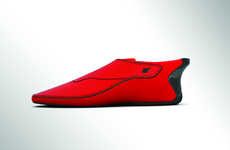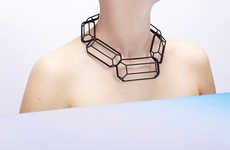
The 'Mushtari' Wearable is Embedded With Living Matter
Rahul Kalvapalle — May 21, 2015 — Lifestyle
References: blog.stratasys & gizmag
The Mushtari is the world's first 3D-printed photosynthetic wearable prototype to be infused with living matter. This wearable is constructed from 58 meters of 3D-printed tubes coiled into a mass that mimics the construction of the human gastrointestinal tract.
Developed by MIT professor Neri Oxman, this wearable goes to show that synthetic technology that emulates human organs can be leveraged for research and experimentation; in the future this could allow for medical research to be conducted without having to source, store and dispose of real human matter.
"In the end, it is clear that the incorporation of synthetic biology in 3D-printed products for wearable microbiomes will enable the transition from designs that are inspired by nature, to designs made with and by nature, to possibly designing nature herself," says Professor Oxman.
Developed by MIT professor Neri Oxman, this wearable goes to show that synthetic technology that emulates human organs can be leveraged for research and experimentation; in the future this could allow for medical research to be conducted without having to source, store and dispose of real human matter.
"In the end, it is clear that the incorporation of synthetic biology in 3D-printed products for wearable microbiomes will enable the transition from designs that are inspired by nature, to designs made with and by nature, to possibly designing nature herself," says Professor Oxman.
Trend Themes
1. 3d-printed Wearables - The Mushtari wearable showcases the potential for 3D printing in creating innovative wearable designs.
2. Synthetic Biology - The integration of synthetic biology in wearable microbiomes opens up new possibilities for designing products with and by nature.
3. Organ Emulation - The Mushtari prototype demonstrates the capacity to mimic human organ construction, leading to potential breakthroughs in medical research.
Industry Implications
1. Healthcare - The healthcare industry can explore incorporating synthetic biology and 3D-printing technologies to revolutionize treatments and organ emulations.
2. Biotechnology - The biotechnology industry can leverage the integration of synthetic biology in wearable technology to create new and innovative products.
3. Fashion - The fashion industry can explore the use of 3D printing and living matter integration to create unique and sustainable wearable designs.
4.9
Score
Popularity
Activity
Freshness























